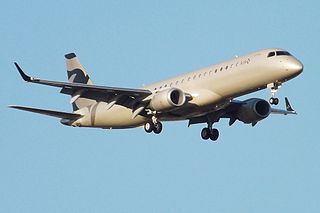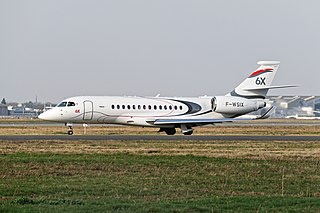Related Research Articles

The Cessna Citation X is an American mid-size business jet produced by Cessna and part of the Citation family. Announced at the October 1990 NBAA convention, the Model 750 made its maiden flight on December 21, 1993, received its type certification on June 3, 1996, and was first delivered in July 1996. The updated Citation X+ was offered from 2012 with a 14 in (360 mm) cabin stretch and upgraded systems. Keeping the Citation III fuselage cross section, it has a new 37° swept wing with an area of 527 ft² for a fast Mach 0.935 MMO and a 36,600 lb MTOW for a 3,460 nmi (6,408 km) range, a T-tail and two 7,034 lbf (31.29 kN) AE3007 turbofans. After 338 deliveries, production ended in 2018.

The Gulfstream G550 is a business jet aircraft produced by General Dynamics' Gulfstream Aerospace unit in Savannah, Georgia, US. The certification designation is GV-SP. A version with reduced fuel capacity was marketed as the G500. Gulfstream ceased production of the G550 in July 2021.

The Bombardier Global Express is a large cabin, long-range business jet designed and manufactured by Bombardier Aviation. Announced in October 1991, it first flew in October 1996, received its Canadian type certification in July 1998 and entered service in July 1999. Initially powered by two BMW/Rolls-Royce BR710s, it shares its fuselage cross section with the Canadair Regional Jet and Challenger 600 with a new wing and tail.

The Dassault Falcon 7X is a large-cabin, 5,950-nautical-mile [nmi] range business jet manufactured by Dassault Aviation, the second largest of its Dassault Falcon line. Unveiled at the 2001 Paris Air Show, its first flight took place on 5 May 2005 and it entered service on 15 June 2007. The Falcon 8X, first delivered on 5 October 2016, is derived from the 7X and has an extended range of 6,450 nmi made possible through engine optimization, aerodynamic refinements as well as an increase in fuel capacity. Featuring an S-duct central engine, the 7X, 8X and the Falcon 900 are the only trijets still in production, as of 2024.

The Dassault Falcon is a family of business jets, manufactured by Dassault Aviation. Dassault produce the midsize Falcon 2000S/LXS twinjet, the long-range Falcon 900LX trijet and ultra-long range Dassault Falcon 7X/8X trijets.

The Embraer Legacy 600 is a business jet derivative of the Embraer ERJ family of commercial jet aircraft.

The Dassault Falcon 900, commonly abbreviated as the F900, is a French-built corporate trijet aircraft made by Dassault Aviation.

The Embraer Lineage 1000 is a variant of the Embraer 190 regional jet airliner, launched as a private jet on May 2, 2006. Manufactured by the Brazilian aerospace firm Embraer until 2017, the Lineage was advertised as an "ultra-large" business jet with seating for up to 19 passengers.

The Pratt & Whitney Canada PW300 series is a family of turbofan jet engines developed by Pratt & Whitney Canada specifically for business jet applications.
Integrated modular avionics (IMA) are real-time computer network airborne systems. This network consists of a number of computing modules capable of supporting numerous applications of differing criticality levels.

The Cessna Citation Excel is an American midsize business jet in the Cessna Citation family. Announced in October 1994, the Model 560XL first flew on February 29, 1996, certification was granted in April 1998, and over 1,000 have been delivered. The 2,100 nmi-range (3,900 km), 20,200 lb MTOW jet is powered by two 3,650–4,080 lbf (16.2–18.1 kN) PW545 turbofans, has the cruciform tail and unswept supercritical wing of the Citation V (560), and a slightly shortened Citation X stand-up cabin. The XLS 2004 update had upgraded engines and a glass cockpit and the 2008 XLS+ had upgraded engines and a revised nose.

The Dassault Falcon 2000 is a business jet produced by French Dassault Aviation, a member of its Falcon business jet line. Developed from the Falcon 900 trijet, the smaller twinjet has less range.
Universal Avionics Systems Corporation, also known as Universal Avionics, is an international company headquartered in Tucson, Arizona in the United States. It primarily focuses on flight management systems (FMS) and cockpit instrument displays for private, business, and commercial aircraft. The company has domestic offices in Arizona, Kansas, Washington, and Georgia, and overseas offices in Switzerland.

The Gulfstream G650 is a large business jet produced by Gulfstream Aerospace. The model is designated Gulfstream GVI in its type certificate. The aircraft can be configured to carry from 11 to 18 passengers over a range of 7,000 nautical miles [nmi] at a top speed of Mach 0.925. The aircraft is powered by two Rolls-Royce BR725 turbofans, mounted on the rear fuselage. Gulfstream began the G650 program in 2005 and revealed it to the public in 2008. The G650ER is an extended-range version of the G650, adding about 500 nmi by modifying the fuel system, an upgrade offered for existing G650 aircraft.

The Gulfstream G400, G500, and G600 (GVII) are twin-engine business jets designed and produced by Gulfstream Aerospace. The aircraft are designated Gulfstream GVII-G500 and GVII-G600 in their type certificate.

The Honeywell HTF7000 is a turbofan engine produced by Honeywell Aerospace. Rated in the 6,540–7,624 lbf (29.09–33.91 kN) range, the HTF7000 is used on the Bombardier Challenger 300/350, Gulfstream G280, Embraer Legacy 500/450 and the Cessna Citation Longitude. Its architecture could be extended for a range of 8,000 to 10,000 lbf thrust.

Honeywell Primus is a range of Electronic Flight Instrument System (EFIS) glass cockpits manufactured by Honeywell Aerospace. Each system is composed of multiple display units used as primary flight display and multi-function display.
The Cessna Citation Hemisphere was a business jet project by Cessna. Announced in November 2015, it was then expected to fly in 2019 but its development was suspended in April 2018 due to a delay in the development of its Safran Silvercrest engines. It was designed for Mach 0.9 and would have a 4,500 nautical miles (8,300 km) range.
LunaJets is a private jet broker with headquarters in Geneva, Switzerland, where it has been based since it was founded in 2007 by former Ogilvy advertiser Eymeric Segard. Additionally, they have opened offices throughout the years in London, Paris, Monaco, Riga and Dubai.

The Dassault Falcon 6X is a large, long-range business jet developed by Dassault Aviation in France. Its precursor, the Falcon 5X twinjet, was launched in 2013, rolled-out in 2015 and made its first flight on July 5, 2017, but its development was frozen as its Safran Silvercrest engine failed to meet performance objectives. In December 2017, the Falcon 6X was launched as a stretched version with PW812D turbofans, made its first flight on 10 March 2021, and entered service on 30 November 2023.
References
- ↑ "Dassault présente le Falcon 900LX à faible consommation". Le Figaro. 2008-05-20. Archived from the original on 2011-07-21. Retrieved 2008-02-09.
The aircraft comes standard with the award-winning EASy flight deck. The EASy flight deck is designed to reduce pilot workload and improve pilot interaction through elevated situational awareness in the cockpit. Today, over 215 EASy equipped aircraft are in operation.
- ↑ "Dassault Falcon EASy Flight Deck" (PDF). Honeywell. 2008-05-20. Archived from the original (PDF) on 2010-08-21. Retrieved 2008-02-09.
- 1 2 "Dassault Falcon's EASy Flight Deck Celebrates One Year Anniversary with Prestigious Industry Safety Award". Dassault Aviation. 2004-12-17. Archived from the original on 2006-10-24. Retrieved 2008-09-27.
- ↑ "Honeywell's Primus Epic has One More to Go". Aviation Week. 2003. Retrieved 2008-09-27.
- ↑ "Technical hurdles delay Primus Epic program". ainonline.com. 2003-08-01. Archived from the original on 2010-07-16. Retrieved 2008-09-27.
When Honeywell started the development program no one had ever certified an MAU. There were no regulations or TSO standards to follow and so Honeywell had to start from square one, working with the FAA and JAA to set the standards for what an MAU would be.
- ↑ "Dassault Falcon announced the launch of 'EASy Phase II' at NBAA". skycontrol.net. 2008-10-06. Archived from the original on 2008-10-12. Retrieved 2008-09-27.
Dassault Falcon announced the launch of 'EASy Phase II', a host of enhancements to the award-winning flight deck that will include synthetic vision technology.
- ↑ "Dassault EASy 2". Honeywell . Retrieved 2012-05-06.
- ↑ "EASy II offers major upgrade for Falcon fliers". ainonline.com. 2011-05-26. Retrieved 2017-02-26.
- ↑ "Automatic dependent surveillance-broadcast OUT" (PDF). Eurocontrol. 2008-10-06. Archived from the original (PDF) on 2010-03-08. Retrieved 2007-10-09.
- ↑ "EASy II Certification Granted by EASA and FAA for the Falcon 900LX". Dassault Aviation. 2011-06-20. Retrieved 2017-02-26.
- ↑ "EASy II Granted FAA and EASA Approval for Falcon 7X". Dassault Aviation. 2013-05-20. Retrieved 2017-02-26.
- ↑ "Dassault Falcon EASY Flight Deck" (PDF). Honeywell. July 2005. Archived from the original (PDF) on 2010-08-21. Retrieved 2008-02-09.
The heart of the EASy platform is two, dual-channel, cabinet-based modular avionics units (MAUs). Highly rationalized, the MAU integrates functional cards for several applications into a single module. Each functional card performs multiple tasks previously requiring dedicated computer processors.
- ↑ "DDC-I In Action". ddci.com. Archived from the original on 2012-04-21. Retrieved 2012-04-22.